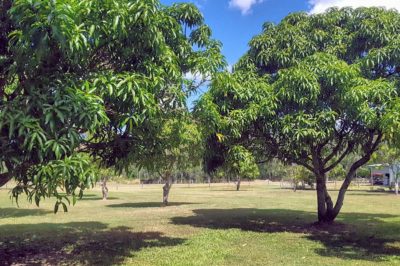Mango Tree Description
Mango trees develop into large, lush, evergreen trees with most cultivars requiring a large area in the landscape to reach their full size. However, dwarf varieties are available that grow well in large containers. Some of the tree’s basic characteristics include:
- Size: If left unpruned, mango trees can grow as tall as 100 feet, with a width about half their height.
- Foliage: Large, leathery and oblong green leaves grow up to 16 inches long and each leaf can live up to five years. Depending on the cultivar, immature foliage range in colors of amber, reddish, pink, yellow or a pale green.
- Tree Shape: Mango trees develop into symmetrical, rounded canopies.
- Flowers: In spring, large flower panicles with multiple branches form on the tips of branches. Each panicle grows up to 16 inches long and can hold anywhere from 500 to 4000 flowers. The majority of the flowers are male and the remainder bisexual.
Mango Tree Races
Mango trees are divided into two different races: Indochinese and Indian. Both types have the same requirements for growth and have similar looks, but there are differences between the two.
Indochinese Mango Trees
Indochinese mangos are more tolerant to humid conditions than Indian types, and are relatively resistant to mildew and anthracnose. Fruits are usually greenish or yellow and elongated. The seeds are polyembryonic, which means if you plant one the developing seedling will produce the same type of fruit as the parent tree.
Indian Mango Trees
Indian mango trees are less tolerant to humidity and more susceptible to mildew and anthracnose. The fruits are very colorful, usually in mixes of reds, purples, yellow and greens and oblong-shaped. The seeds are monoembryonic, which means if you plant a seed the fruit produced can be the same, superior or not as good as the parent tree.
Mango Fruit
Depending on your climate and variety of mango tree you are growing, mango fruit is ripe and ready for harvesting anywhere from May through September. The mangoes will ripen on the tree, but they can be picked when the fruits are still firm and have fully matured in size. In addition, it can take anywhere from several days to a week for the fruit to become ready for eating.
One good thing about mangoes are you don’t have to harvest all the fruit at one time. You can leave the fruit on the tree until you are ready to eat it. As the season continues and if you don’t pick the mangoes, the fruit will eventually drop off the tree.
Expert Tip: The flesh of the mango is ripe and ready to eat once it changes from white to a yellowish color. You do not eat the skin. Store your harvested mangoes in a location with temperatures between 70 to 75°F (21 to 24°C). After the mango is ripe, you can store it in the refrigerator. Wash the mango after picking to remove the sap. Otherwise, the sap causes spotting, which leads to rot.
